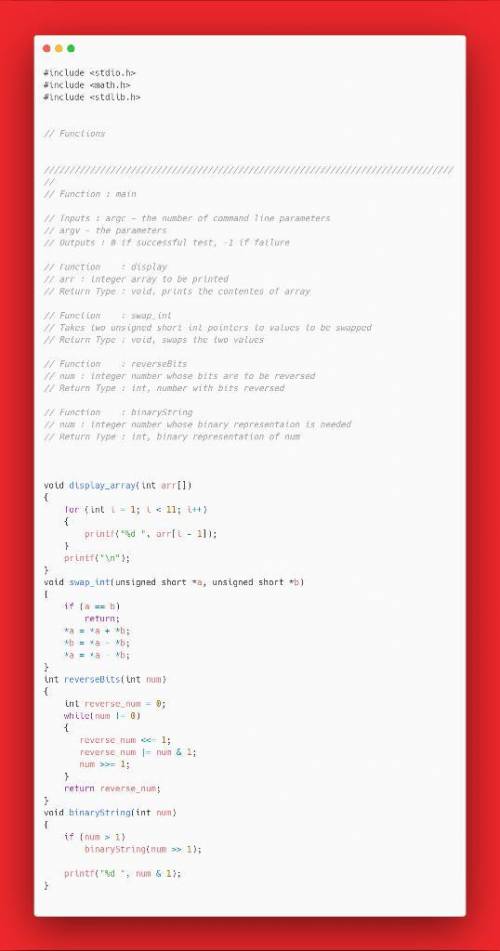
Computers and Technology, 10.03.2020 08:56 cinthyafleitas
Complete the commented parts in the code below:
#include
#include
#include
// Functions
//
// Function : main
// Inputs : argc - the number of command line parameters
// argv - the parameters
// Outputs : 0 if successful test, -1 if failure
// Function : ???
// ???
int main(int argc, char *argv[]) {
// Local variables
// NOTE: this is where you will want to add some new variables
int int_array1[10], int_array2[10];
unsigned int uint_array1[10];
int i;
//
if (argc < 11)
{
printf("Exiting the program, missing input");
return 0;
}
// Step a - read in the integer numbers to process
for (i=1; i<11; i++) {
int_array1[i-1] = atoi(argv[i]);//converting input to integer
}
// Step b - Convert numbers into positive values by taking their
// absolute values and save them in int_array2.
// Print all numbers in a single line using display_array function
//
// Step c - Convert these positive integers to numbers
// in the range 0,…,128 by implementing the mod operation
// save them back into int_array2.
// Print all numbers in a single line using display_array function
//
// Step d - for each integer in int_array2 print:
// number, number of 1 bits, even or odd
//
// Step e - Cast each element of int_array2 to unsigned short
// and store them into uint_array1.
//
// Step f - Reverse the order of array elements in uint_array1
// using swap_int function.
/*swap_ints(): function should swap the numbers without using
temp variable*/
// Step g - Update each element of uint_array1 by using reverseBits function.
/* reverseBit(): The function should return the number (in
integer format) whose bits are reversed,
i. e., the top bit of the original number is
the bottom bit of the returned number, the
second from the top bit of the original
number is the second to the bottom bit of
the returned number. */
// Step h - Print each element of uint_array1 in a separate line along with
// binary representation of each of the numbers using binaryString function.
/* binaryString():This function should fill the text string
with a binary representation of the number
suitable for printing. You should be using
some bitwise operations to achieve this,
maybe shifting(<<) and and (&)
operation
*/
// Return successfully
return(0);
}

Answers: 3
Another question on Computers and Technology

Computers and Technology, 22.06.2019 06:00
Write a function that draws a pool ball. this function should take as parameters, the color, the number that should go on the pool ball, and the location of the center of the pool ball. the radius of the pool balls should be pool_ball_radius, and the font of the number should be pool_ball_font. the text of the pool ball font should be white. drawpoolball(color.orange, 5, 100, 100); drawpoolball(color.green, 6, 50, 200); drawpoolball(color.red, 3, 150, 350); drawpoolball(color.blue, 2, 250, 140); to center the numbers on the pool ball, you should use the getwidth() and getheight() methods. you are allowed to call these methods on your text object, such as txt.
Answers: 3

Computers and Technology, 22.06.2019 12:10
Linux is distributed under gnu gpl. why is this important? a. it ensures that only torvalds can profit from the sale of linux b. it prevents unknowledgeable users from downloading programs they don't know how to operate. c. it provides protection for the developers who created linux. d. it states that anyone can copy, modify, and share the program if changes are made public.
Answers: 1

Computers and Technology, 22.06.2019 16:00
Why should characters such as / \ " ' * ; - ? [ ] ( ) ~ ! $ { } < > # @ & | space, tab, and newline be avoided in file names?
Answers: 2

Computers and Technology, 24.06.2019 06:30
For which utilities, if any, does the landlord pay?
Answers: 2
You know the right answer?
Complete the commented parts in the code below:
#include
#include
#include...
#include
#include
#include...
Questions

French, 19.07.2019 01:50

History, 19.07.2019 01:50

Social Studies, 19.07.2019 01:50


History, 19.07.2019 01:50

Spanish, 19.07.2019 01:50


Mathematics, 19.07.2019 01:50






Advanced Placement (AP), 19.07.2019 01:50

Social Studies, 19.07.2019 01:50




Biology, 19.07.2019 01:50






